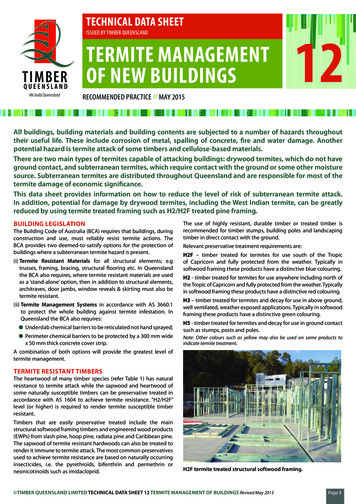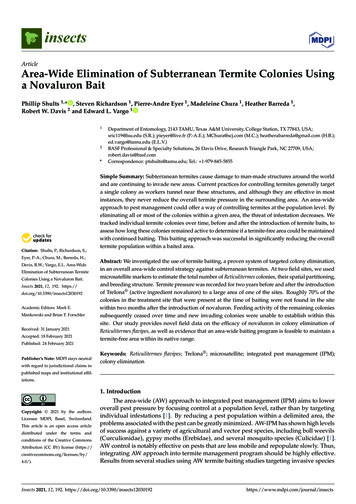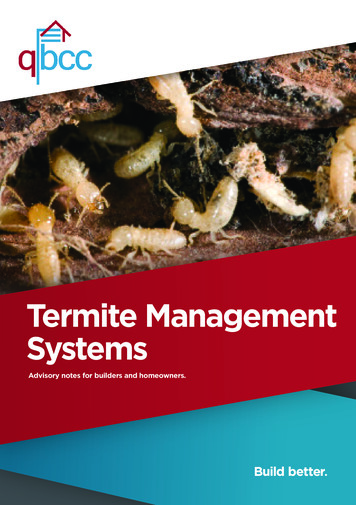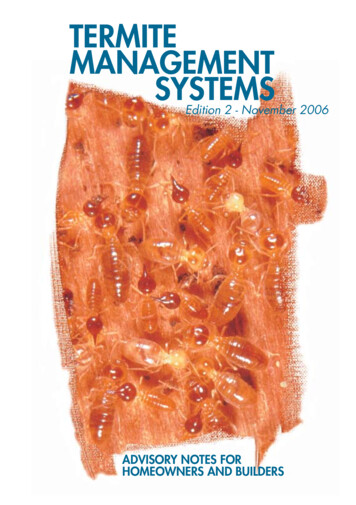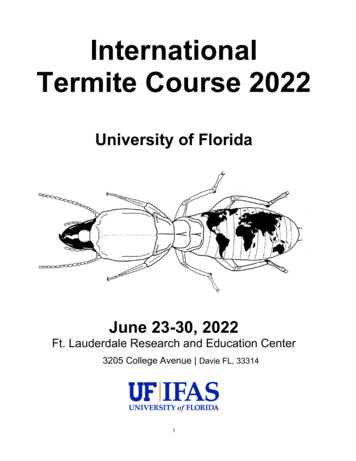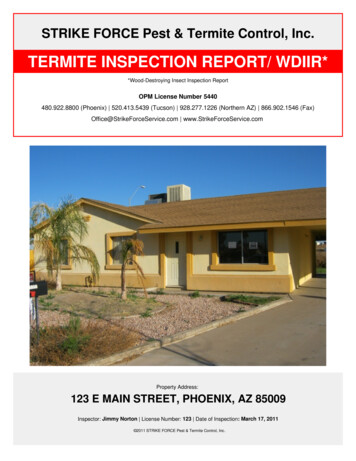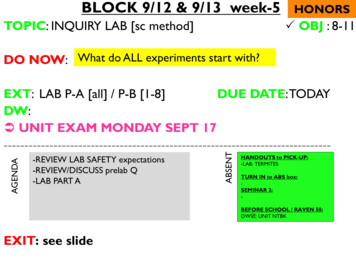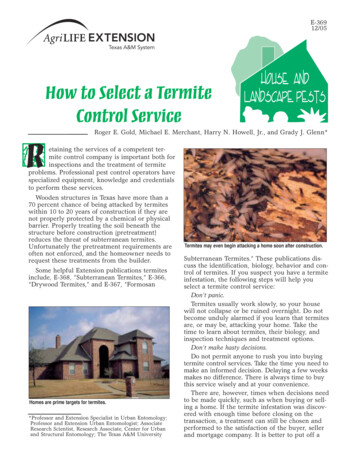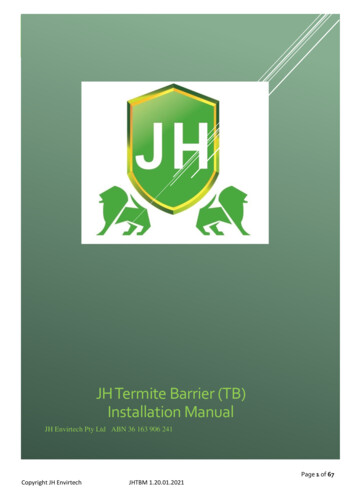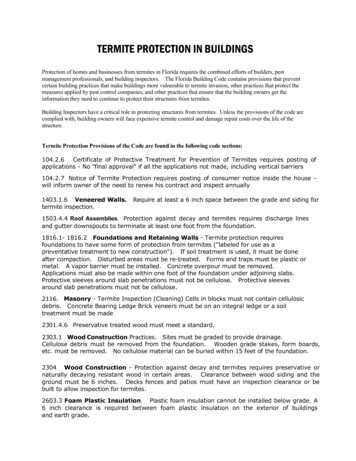
Transcription
TERMITE PROTECTION IN BUILDINGSProtection of homes and businesses from termites in Florida requires the combined efforts of builders, pestmanagement professionals, and building inspectors. The Florida Building Code contains provisions that preventcertain building practices that make buildings more vulnerable to termite invasion, other practices that protect themeasures applied by pest control companies, and other practices that ensure that the building owners get theinformation they need to continue to protect their structures from termites.Building Inspectors have a critical role in protecting structures from termites. Unless the provisions of the code arecomplied with, building owners will face expensive termite control and damage repair costs over the life of thestructure.Termite Protection Provisions of the Code are found in the following code sections:104.2.6Certificate of Protective Treatment for Prevention of Termites requires posting ofapplications - No "final approval" if all the applications not made, including vertical barriers104.2.7 Notice of Termite Protection requires posting of consumer notice inside the house will inform owner of the need to renew his contract and inspect annually1403.1.6 Veneered Walls.termite inspection.Require at least a 6 inch space between the grade and siding for1503.4.4 Roof Assemblies. Protection against decay and termites requires discharge linesand gutter downspouts to terminate at least one foot from the foundation.1816.1- 1816.2 Foundations and Retaining Walls - Termite protection requiresfoundations to have some form of protection from termites ("labeled for use as apreventative treatment to new construction"). If soil treatment is used, it must be doneafter compaction. Disturbed areas must be re-treated. Forms and traps must be plastic ormetal. A vapor barrier must be installed. Concrete overpour must be removed.Applications must also be made within one foot of the foundation under adjoining slabs.Protective sleeves around slab penetrations must not be cellulose. Protective sleevesaround slab penetrations must not be cellulose.2116. Masonry - Termite Inspection (Cleaning) Cells in blocks must not contain cellulosicdebris. Concrete Bearing Ledge Brick veneers must be on an integral ledge or a soiltreatment must be made2301.4.6 Preservative treated wood must meet a standard.2303.1 Wood Construction Practices. Sites must be graded to provide drainage.Cellulose debris must be removed from the foundation. Wooden grade stakes, form boards,etc. must be removed. No cellulose material can be buried within 15 feet of the foundation.2304 Wood Construction - Protection against decay and termites requires preservative ornaturally decaying resistant wood in certain areas. Clearance between wood siding and theground must be 6 inches. Decks fences and patios must have an inspection clearance or bebuilt to allow inspection for termites.2603.3 Foam Plastic Insulation. Plastic foam insulation cannot be installed below grade. A6 inch clearance is required between foam plastic insulation on the exterior of buildingsand earth grade.
Frequently asked questions:1. Can I use the baiting system for termite prevention?Section 1816.1 of the Code states that termite preventive treatments can be provided by soil applied insecticides,termite bait systems, and wood treatments. DCA 03 - DEC-222, also addresses baiting systems.2. With regard to termite bait systems, when does the clock start for the five years for thecontract/monitoring?Chapter 482, Florida Statutes, requires that pest control licensees provide a contract to property owners for whichpreventive treatment for termites is provided. This contract must include a warranty for retreatment only or forretreatment and damage repair for one year with the option for automatic renewal for up to four additional yearsupon the payment of an annual renewal fee, with no increase in the renewal fee for the first four renewals per thecontract. An increase in renewal fee is allowed if the contract specifies that the fee may be increased. The timeperiod begins with the effective date of the contract, typically the date the treatment is performed.3. What happens if a contract for maintenance and monitoring is terminated after the CO is issued, but prior tothe conclusion of the required five years?If the property owner does not choose to pay for the renewal of the termite protection contract, the pest controllicensee is not obligated to renew the contract. The pest control licensee must renew the contract if the annualrenewal fee is paid. This applies to all types of preventive treatment.4. Is a termite baiting system which consists of monitoring stations containing wooden stakes an acceptableproduct for use in new construction for the purpose of protecting new homes from termites?Preventive treatment must be provided by a registered termiticide or alternative means approved by buildingofficials (Section 1816.1) A termite bait system registered as a pesticide for the preventive treatment for newconstruction will consist of more than wooden stakes, but will also include a pesticide active ingredient. The system willalso have to meet the performance standards established in Chapter 5E-2.0311, FAC to be eligible forregistration. Some registered termite bait systems include a component for monitoring that consist of wooden stakes orequivalent. Provided that these are used in a manner that is consistent with the directions for use of the registered termitebaiting system, they are part of the protection system for the structure.5. When a baiting system is used, at what time would application of a pesticide be required?Some baiting systems registered as preventive treatments for new construction contain the pesticide activeingredient as part of the initial installation, others require installation of the active ingredient after termite activity isdetected. The time of installation of the active ingredient is specified in the directions for use on the label of thepesticide.6. What type of termite protection products/systems are required by the code?The Code requires that termite protection be provided by a registered termiticide, including soil applied termiticides, baitsystems, or pesticides labeled for direct application to wood, or an alternative method approved by the building official.All three kinds of products are registered in Florida.7. Does the code require treatment of ground for structures which will not have wood products in it; e.g.preengineered metal buildings, or aluminum buildings?The code requires preventive treatment for any structure with a foundation. Termite infestations occur in anystructure that contains cellulose, and even metal buildings will contain cellulose in the form of wood finishing and
furnishings, stored paper or other cellulose articles, etc.8. What is the minimum clearance between exterior wall coverings and final earth grade on the exterior of abuilding in order to provide for inspection for termite infestation?Section 1403.1.6 requires a minimum of six inches clearance to allow for detection of termite foraging and mudtubes entering a structure. If this gap is not provided, termite infestation may occur undetected.9. How far should condensate lines and roof downspouts discharge from a structure’s sidewall, to preventdecay and termites?Section - 1503.4.4 of the Code requires a discharge at least 12 inches from the foundation. This will aid inminimizing moisture at the foundation which is conducive to termite infestation.10. Is termite treatment required when Foam plastic insulation is installed below grade on foundation walls?Section - 2603.3.1 of the Code prohibits installation of foam plastic below grade on foundation walls with certainexceptions. Installation of foam plastic insulation below grade creates an avenue for termite infestation and can defeattermite preventive measures.11. At what stage of construction should soil treatment for subterranean termite prevention, be applied?The application of soil applied insecticides for preventive treatment of new construction depends on the creation of atreated zone under and around the foundation of a structure. This is accomplished by three stages of application - to thecompacted soil of a foundation prior to the pouring of a slab, along both sides of stem walls, under adjoining slabs, andalong the exterior of the foundation when construction is completed. This final application has to beaccomplished prior to the issuance of the certificate of occupancy.12. If the soil is disturbed after initial chemical soil treatment, is there a requirement to re-treat?Section 1816 of the Code, requires this to be done.13. Who is responsible to retreat when soil is disturbed, the contractor or the pest control company?In order to be in compliance with the Code, the contractor should contact the pest control company to conduct aretreatment.14. Is a vapor retarder required to protect the treated soil against rainfall dilution?Installation of a vapor barrier is a requirement of the label directions of soil applied insecticides when applied prior tothe pouring of concrete slabs. The vapor barrier also protects flooring from sub-slab moisture penetration.15. The code requires a protective sleeve around metallic piping penetrating concrete slab-on-grade floorswhen soil treatment is used for subterranean termite protection. Is the annular space between protectivesleeve and pipe required to be treated?Treatment of the annular space is a requirement by Section 1816.2 of the code. It is necessary to prevent termitesfrom breaching the treated soil zone under a slab when the soil treatment is the preventive method used.16. What is the minimum required clearance between the ground and insulated concrete forms.Section - 1916.7.5.1 requires clearance between earth and insulated concrete forms (ICF) to be not less than 6inches.17. What is the role of the Department of Agriculture relative to termite protection?
The Department of Agriculture and Consumer Services licenses and inspects pest control companies and registers thepesticides used for preventive treatment for new construction.18. Are products for termite protection required to be approved? If so, who is responsible for the approval?The products used for this purpose are pesticides, and are not “approved” as such, but are either eligible forregistration or not eligible. Pesticides that include directions for use as preventive treatments for new constructioncan be registered if they meet the requirements of Chapter 5E-2.0311, Florida Administrative Code. This rule isadministered by the Florida Department of Agriculture and Consumer Services. A list of pesticides registered aspreventive treatment for new construction can be accessed at www.flaes.org.19. What are the Statutes and Rule (FAC) that governs termite protection?Chapter 482, Florida Statutes and Chapter 5E-14, Florida Administrative Code, govern structural pest control inFlorida. The Bureau of Entomology and Pest Control of the Department of Agriculture and Consumer Services is theregulatory body responsible for administering this statute and rule.20. When is a vertical treatment required and what are the specifications relative to the distance from theperimeter of the building?Vertical treatment is the application of a soil applied termiticide to the soil around the exterior of a foundation. Thespecifications for this application are included in the directions for application on the label of the pesticide.Typically the directions are for an application of four gallons of insecticide mixture per ten linear feet of foundation,immediately adjacent to the foundation.21. What is the responsibility of local building departments relative to the inspection of the termite system andwhat specific things should they inspect?Termite bait systems are registered pesticides and contain label directions that include inspection intervals. It is theresponsibility of the licensed pest control operator to follow label directions in the use of these pesticides. Section 105.11of the Code requires that building components and surroundings required by the Code to be protected from termitedamage must not be covered or concealed until approved by the building official. Questions regardingcompliance with label directions for use by the pest control operator should be directed to the Florida Department ofAgriculture and Consumer Services Bureau of Entomology and Pest Control at 850-617-7997.22. Should inspections be made per manufacturer’s requirements or as required based on the approval of thesystem?Termite bait systems are registered pesticides and contain label directions that include inspection intervals. It is theresponsibility of the licensed pest control operator to follow label directions in the use of these pesticides. Wherethe Code does not provided specific installation instructions for the termite protection system, inspection by thebuilding official must be in accordance with system approval. For all bait systems currently registered, a singleinspection by the building official when construction is completed should be sufficient to verify that the system hasbeen installed.23. Is a license required to apply pesticides, and if so, would that include a contractors license?The application of pesticides (including use of termite bait systems) as preventive treatment of new construction isconsidered pest control. In Florida, a license from the Florida Department of Agriculture and Consumer Services isrequired to perform pest control on property other than your own. Performing pest control without a valid license isillegal.24. Are wood treatments such as borates allowable as stand alone treatments for new construction?Currently there is one product registered as a preventive treatment for new construction as a direct treatment to
wood. This product is a borate containing insecticide.stand alone preventive treatment.As a registered pesticide, this material may legally be used as a25. What should the building official do if the Certificate of Protective Treatment for Prevention of Termiteshas not been provided by the pest control operator but the final inspection has been completed and passed?The Certificate of Protective Treatment for Prevention of Termites must be provided prior to the issuance of theCertificate of Occupancy as per Section 104.2.6 of the code.More information on the Termite Provisions of the Building Code is available from the following sources:Mo MadaniPlanning Manager, CBO2555 Shumard Oak BoulevardTallahassee, Florida n DwinellAssistant DirectorDivision of Agricultural Environmental ServicesFlorida Department of Agriculture and Consumer Services3125 Conner BoulevardTallahassee, Florida 32399850-617-7913Dr. Phillip KoehlerProfessorEntomology DepartmentUniversity of FloridaGainesville, Florida 32611Email: pgk@ufl.eduTel: (352) 392-2484
termite inspection. 1503.4.4 Roof Assemblies. Protection against decay and termites requires discharge lines and gutter downspouts to terminate at least one foot from the foundation. 1816.1- 1816.2 Foundations and Retaining Walls - Termite protection requires foundations to have some form of protection from termites ("labeled for use as a
